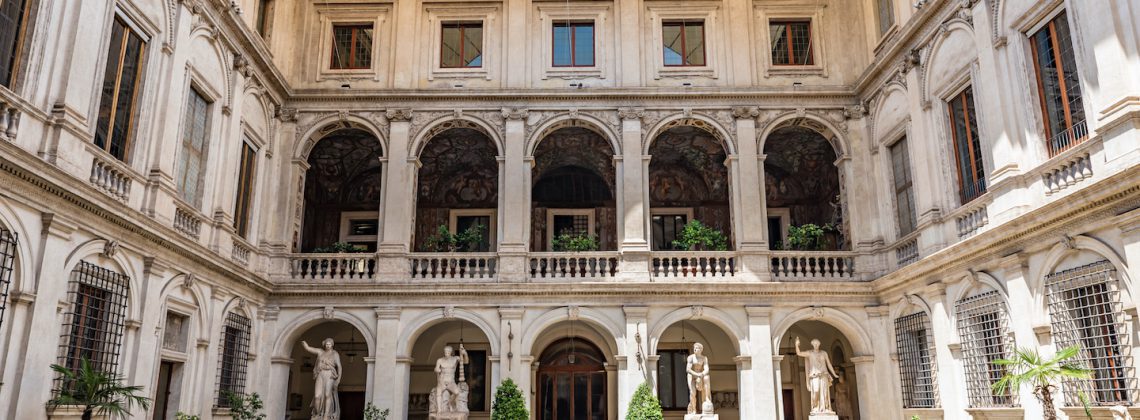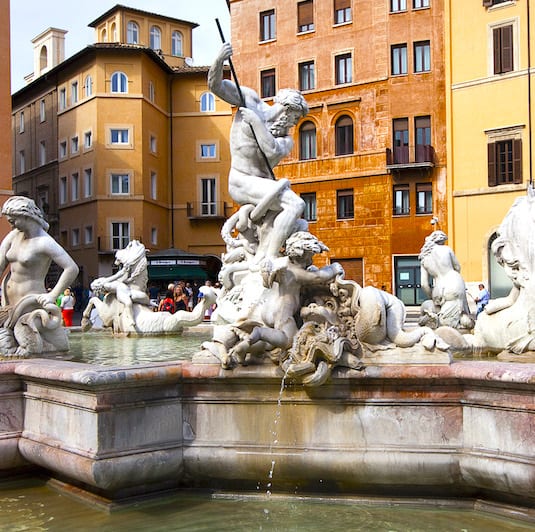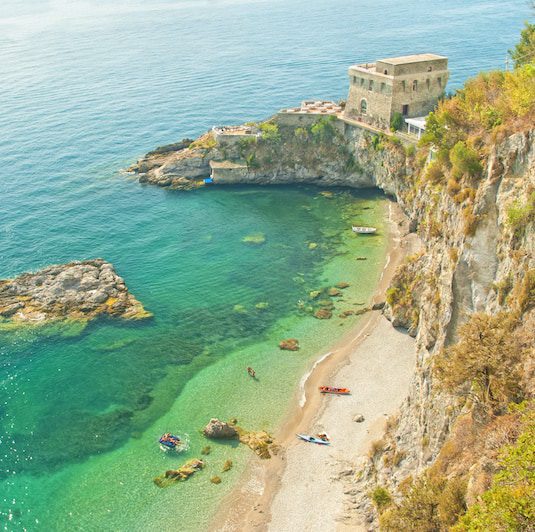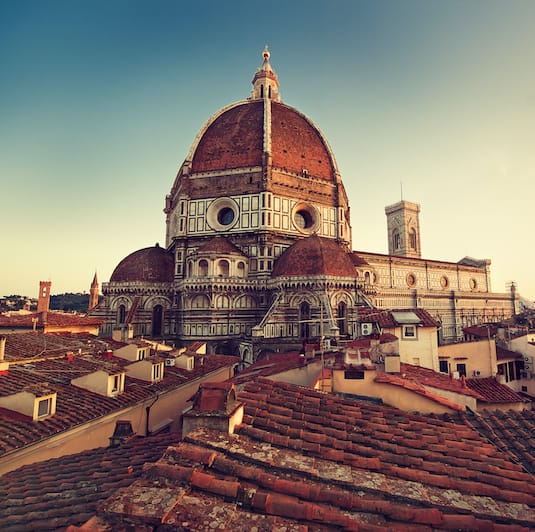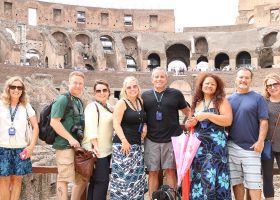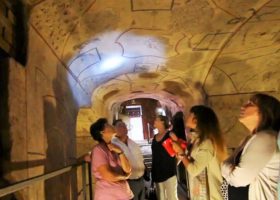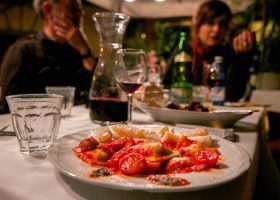Planning your first (or third) trip to Rome? In the Eternal City, there are lots of hidden gems to discover, monuments to explore, and places to experience local life. Deciding what to do can be tough, so we’ve put together this list of the best things to do in Rome, no matter your travel preference.
Our Helpful Planning Articles
The Top Things To Do in Rome
Planning your next trip is always exciting, and Rome, in particular, is an incredible destination. With its long, rich history, there are tons of things to do in the Eternal City.
This list is by no means ex. There’s everything from museums to visit, restaurants to eat at, tours to take, and general things to do to give you a taste of life in Rome.
Not ready to book a tour? Find out if Rome tours are worth it.
1. Visit the Vatican’s Sistine Chapel, Then Sip Cocktails in the Pinecone Courtyard
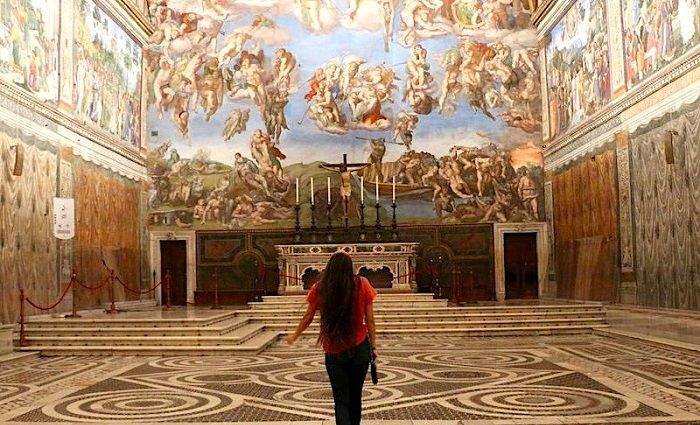
€€+ | Vatican After Hours | VIP | Book in Advance
Any list of top things to do in Rome that doesn’t include the Vatican museums isn’t worth its salt. The Vatican museums are one of the finest collections in the world. But an unplanned visit can quickly go from the trip of your dreams to a nightmare very quickly. I’m not saying you have to take a tour. I mean, we are a tour company, but tours aren’t for everyone, or maybe your budget is tight. You can check out all of our tips for visiting the Vatican here, but if you want something a bit special, then keep on reading.
Undoubtedly, one of the most amazing things you can do in Rome is to visit the Vatican after the crowds have left. If money isn’t an option, then yes, you can visit the Vatican Museums outside of their opening hours. But for the rest of us, the best alternative is the VIP after-hours with aperitivo tour.
Slots are limited, but you’ll be in a group of ten or fewer, and you will be with no more than one hundred people in the Sistine Chapel (normally 2000 + people. Then, after taking all that wonderful art in, you can sip cocktails in the pinecone courtyard. A perfect way to spend any afternoon in Rome.
Take a look at this expensive but truly once-in-a-lifetime Vatican experience or all of our after-hours Vatican experiences. If you’re looking to explore the Mausoleum of Hadrian, walk the historic Ponte Sant’Angelo, and uncover secrets like the Passetto di Borgo, all with access to the Papal Apartments, you’re going to want to check out our Private Castel Sant’Angelo Tour.
Not ready to book a tour? Find out if a Vatican tour is worth it.
2. Channel Your Inner Gladiator on the Colosseum Arena Floor
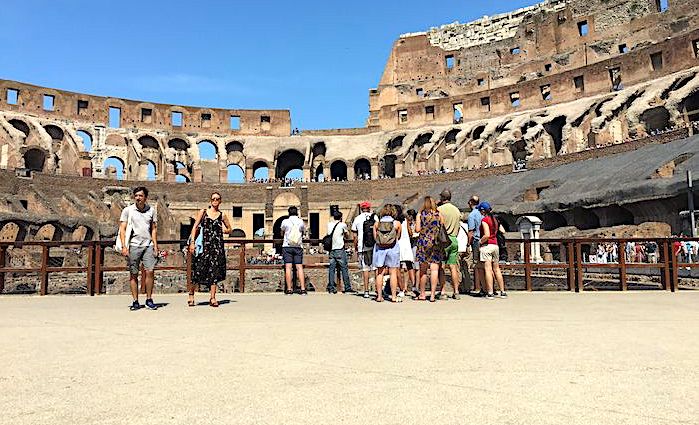
€€ | Colosseum | Archeological Site
Visiting the Colosseum is all about special access these days. You can buy general admission tickets, but you’ll be doing yourself a disservice. Why?
Every day, crowds of people enter the Colosseum, and sometimes it can get overwhelming. So, getting access to areas like the Arena Floor gives you a little space and, to be honest, a better experience.
The stage or Arena Floor has been reconstructed, so you can walk out on it and view the structure much the same as ancient gladiators did. We run great tours with Arena Floor access that will make your visit to the Colosseum 10 times better.
Address: Piazza del Colosseo, 1
Not ready to book a tour? Find out if a Colosseum tour is worth it.
3. Head Underground in Rome’s Catacombs and Crypts
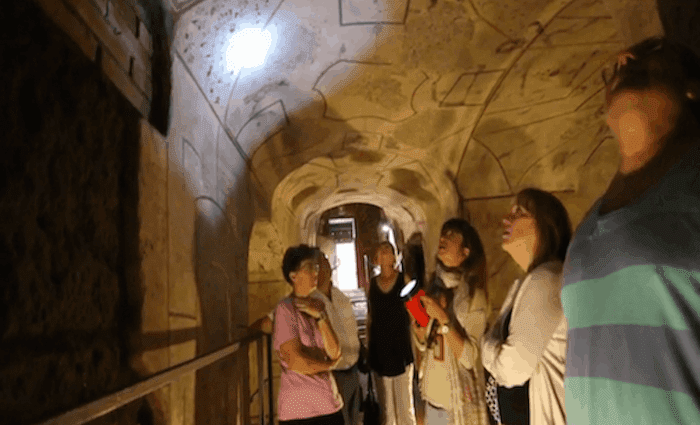
€€ | Archeological Site | Christian Burial Grounds
The ancient Romans were pagans. During different periods, there were varying customs. However, burial was rarely used in Roman times. The pagans burned their dead, and it was mostly for sanitation reasons. Christians were less prevalent at the time of the second century A.D., and the pagans thought it silly that they would want to bury their dead.
If Christians wanted to carry out this custom, they were required to do so outside the walls of Rome. This is how the catacombs came to be used from the second century onward.
You can visit the catacombs of Rome in almost any month of the year—by yourself or with a tour of the catacombs. Tours make it a bit easier as they get you to and from the catacombs and a few other points of interest like the Appian Way and the Capuchin Bone Crypts. Check out our Rome catacomb tours.
Address: Via delle Sette Chiese 282
Not ready to book a tour? Find out if a Rome Catacombs tour is worth it.
4. Eat Gnocchi con Sugo di Carne (Only on Thursdays)

Potato Pasta | Lunch or Dinner | Meat Sauce | Only Thursdays
One of the most wonderful and beautiful things about Rome, and Italy as a whole, is the tradition. Imagine you had rules for everything you ate and drank—but they were wonderful rules that everyone loved and adored because they were based on tradition and culture. That’s how Rome works, and gnocchi is no different. The rule for gnocchi is that the dish is only served on Thursdays in a traditional trattoria in Rome. Why?
Gnocchi is prepared from potatoes and other heavy ingredients. So, a big plate of gnocchi with sugo di carne (tomato meat sauce) is very filling. For this reason, Thursdays can be an exciting day. You can get a plate of gnocchi at a tavola calda or pizza place that serves daily dishes for around €5 on a paper plate or in a to-go container. Boy, are they delicious! Wait, why only on Thursdays?
In Rome, people used to eat only fish on Fridays. This is because meat was prohibited on Fridays as penance on the day of Christ’s death. So, it wasn’t just during Lent but all year round. Fish is delicious, but it’s often a light meal and digested quickly. Romans figured they’d eat gnocchi on Thursdays to fill up in preparation for Friday’s lighter meal. Then, they’d follow that up with la Trippa on Saturdays to balance the scales since it’s also a heavier meal.
Want to be a part of a Roman tradition? Order Gnocchi con Sugo di Carne while in Rome on a Thursday! Also, check out some other top foods to try in Rome from the fork of a Roman!
Where to get the best gnocchi in Rome:
- Osteria di Monteverde —Take a taxi to this super local spot.
- Trattoria da Cesare al Casaletto — If you feel like you’re at the wrong place, you’re in the right place!
Not ready to book a tour? Check out our Best Food Tours to Take in Rome and Why article.
5. Climb To the Top of St Peter’s Basilica
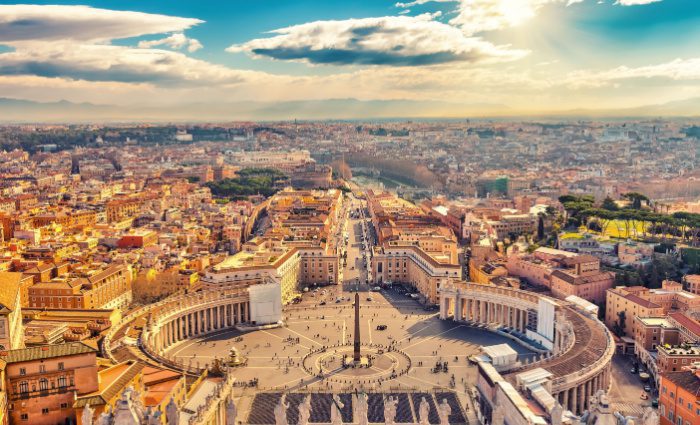
€ | Michelangelo’s Dome | Vatican
St. Peter’s Basilica is an epic structure of massive proportions. The current structure sits on a foundation from the fourth century A.D. by Roman Emperor Constantine. The original basilica was dismantled and rebuilt in the 16th and 17th centuries by basically every Italian artist and architect you’ve ever heard of.
While the basilica is attributed to Bramante, the Dome is the work of Michelangelo himself. A master like Michelangelo would want to show off his work, which is why he constructed it so you can climb to the top! It’s the highest point in Rome and an amazing experience that I highly recommend.
When is the best time to do it? On your first morning in Rome. It’s the ideal way to introduce yourself to Rome and the Vatican, with views most people miss.
Address: Piazza San Pietro
Not ready to book a tour? Find out how to do a St. Peter’s Dome climb.
Check out all of our YouTube videos
6. Find Bernini’s Greatest Sculptures at Borghese Gallery
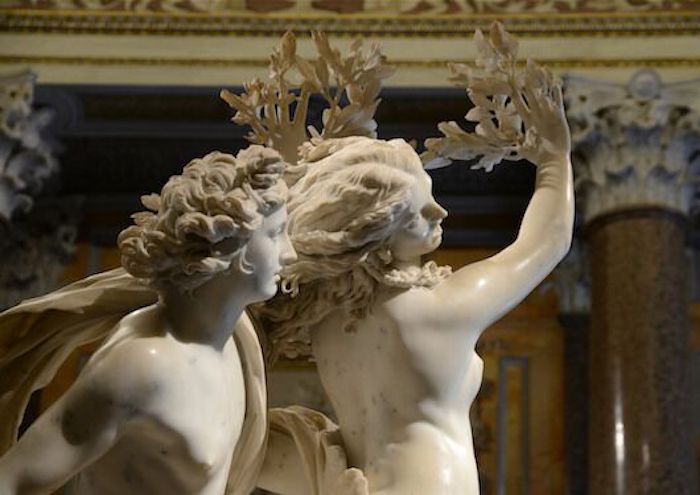
€€ | Limited Entrance Gallery | Greatest Collection of Bernini Sculptures | Sells Out Weeks in Advance
The Borghese Gallery is a small, unassuming museum and Rome’s most enjoyable. One of the reasons is that you can enjoy the space and art without the large crowds of other museums. The gallery has a limit on the number of visitors (360) who can enter at a time and on the time you can spend inside (2 hours).
It’s the perfect amount of time to visit the gallery and see what is arguably one of the greatest collections of Baroque artwork per square foot on Earth. The Borghese Gallery is home to at least ten high-profile works by Gian Lorenzo Bernini. You’ll also find paintings by masters such as Caravaggio, Raphael, Peter Paul Rubens, and more.
The Borghese Gallery is my absolute favorite tour to lead because I really enjoy a good story. Baroque art itself is passionate as evidenced in the sharp movements. Check out our Borghese Gallery tours. It’s a shorter tour and reasonably priced for a private experience—just your group and the guide. It will be a highlight of your art experience in Rome.
Also, find out what you need to know about visiting the Borghese Gallery and see a detailed list of the top things to see at the Borghese Gallery.
Address: Piazzale Scipione Borghese 5 | Admission: €15 (can fluctuate based on exhibitions)
Not ready to book a tour? Check out our Borghese Gallery Guide for more info.
7. Stand at the Best Viewpoints of Rome
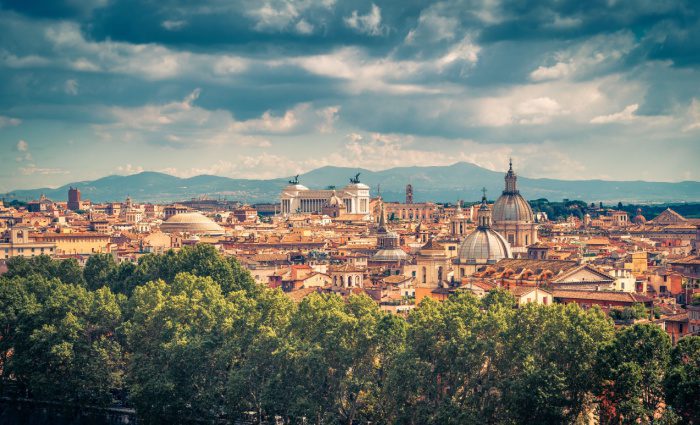
Free | Great Photos
As you may already know, Rome was built on seven hills. Today, the city has expanded beyond its original boundaries, and you’ll find many opportunities to see the skyline from above.
My favorite viewpoint is il Pincio (featured in the image above). It’s part of Villa Borghese and you’ll enjoy some incredible panoramic views of Rome and its landmarks. Here are some of the city’s best viewpoints:
8. Row A Boat in Villa Borghese
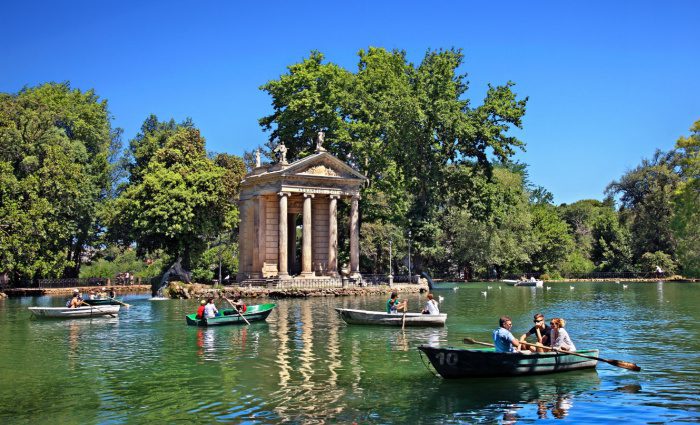
€ | Romantic | Fun for Kids
Villa Borghese is a heart-shaped park that was the residence of Cardinal Scipione Borghese. He developed it into a sort of secret garden with peacocks and exotic animals running around.
It’s home to the Borghese Galleria, the cardinal’s former residence, and other points of interest you’ll want to check out. Also, you can walk around the park and take in the sights, and I definitely recommend renting a rowboat in Laghetto di Villa Borghese on a nice day. Here are some other points of interest in Villa Borghese:
- Il Pincio (mentioned above)
- Museo e Galleria Borghese
- Laghetto di Villa Borghese and Temple of Asclepius
- Bioparco di Roma (nice zoo for kids)
- Casina Valadier (great to see from the outside or to have dinner)
- Valle dei Cani (Dog Valley for dog lovers—I used to take my dog here daily)
Besides renting a rowboat, some other great things to do in Villa Borghese are a DIY Rome Walking Tour and taking a Private Borghese Gallery Tour.
Address: Piazzale Napoleone I
Not ready to book a tour? Check out our Borghese Gallery Guide for more info.
9. Visit an Almost-Abandoned Museum
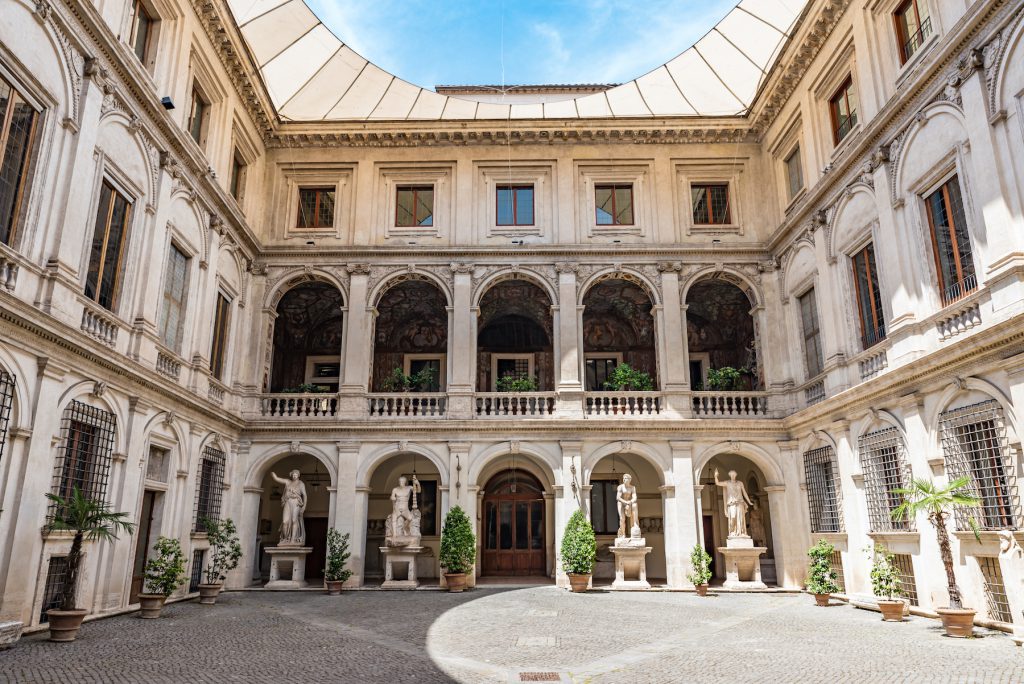
€ | Palazzo Altemps | Suicidal Gaul
There’s one thing I like to do every time I go to Rome: visit Palazzo Altemps to see the Suicidal Gaul. The second is to see the Ludovisi Battle Sarcophagus, which is an absolutely breathtaking relief—words really can’t describe it! Lucky for you, they’re found in the same room!
This, like most museums in Rome, is a private collection that was eventually handed over to the state as a gift or in the absence of heirs. Here are some important works to see at this museum:
- Throne with the Birth of Venus
- Ludovisi Dionysus
- Ludovisi Throne
- The Suicidal Gual
- Ludovisi Battle Sarcophagus
- The Courtyard
The best way to see Palazzo Altemps is through the eyes of a local guide. Check out our private tour of Palazzo Altemps, which also dives into the underground ruins of Domitian’s Stadium below Piazza Navona!
Address: Piazza di Sant’Apollinare, 46
Not ready to book a tour? Check out our best Rome tours to take and why.
10. Explore the Fountain and Church in Piazza Navona
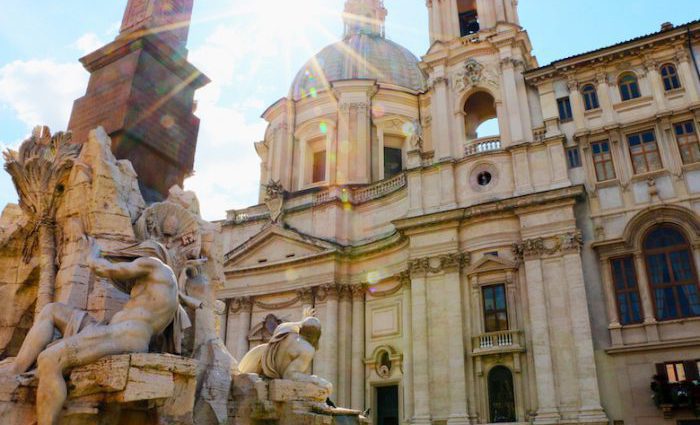
Free | Stop By Attraction | Four River Fountain by Bernini
Piazza Navona is a very unique piazza and a must-visit site. It’s completely pedestrian and lined with restaurants and cafes. You can stroll through on foot to admire its three fountains with its famed central Four River Fountain by Gian Lorenzo Bernini.
Bernini’s fountain is framed by the breathtaking church of St. Agnus in Agony, which was designed by the Rainaldi father-and-son team along with Francesco Borromini. There are old wives’ tales about the relationship between this church and Bernini’s fountain, which were undoubtedly created out of the bitter rivalry between Borromini and Bernini.
Bernini was chosen for a commission of Palazzo Barberini over Borromini, which is likely where this rivalry began. As the story goes, Bernini’s statue representing the Nile River holds its hand out towards the church as if bracing for it to fall due to architectural incompetence. However, it’s very unlikely that this was the hidden meaning—the fountain was built years before the church.
Be sure to check out these top things to see in Piazza Navona. You can take a Rome in a Day tour that includes this piazza and many other sites. We also run a great private tour that explores the ruins of Domitian’s Stadium below Piazza Navona! When you get hungry, stop by one of these five great restaurants near Piazza Navona.
Address: Piazza Navona
Not ready to book a tour? Check out our best Rome tours to take and why.
Subscribe to our Youtube channel here
11. Taste Authentic Rome on a Food Tour

€€ | Full Meal | Wine and Beverages Included
Food tours are all the craze in Europe because they’re the best way to sample a variety of authentic dishes with a local. We entered the food tour arena in 2013 and have focused much of our efforts on the ever-changing Trastevere neighborhood.
Our tour starts in Campo de Fiori and heads across the Ponte Sisto into Trastevere—it’s the perfect mix of walking and eating! You’ll visit many stops, up to six, eating and drinking along the way.
Doing a food tour is a must for anyone visiting Rome, Florence, or Venice. See our Trastevere Local Food Tour in Rome and also take a peek at our other food tours across Europe.

Not ready to book a tour? Find out if a Rome food tour is worth it.
12. Find the Dying Gaul at the Capitoline Museum
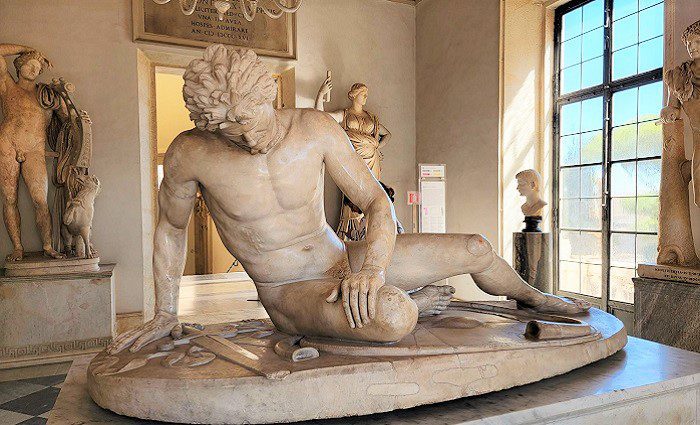
€ | Museum Complex | Roman Walls | Gaul Sculpture
The Musei Capitolini or Capitoline Museum is definitely the full package. The theme of the museum is more ancient history, which is befitting as it sits on the outer edge of the Roman Forum with one of the best views. The Capitoline Museum is a three-building complex comprised of:
- Palazzo Senatorio—built in the 12th century and updated by Michelangelo himself. Also, it overlooks the forum.
- Palazzo dei Conservatori—built in the 16th century and also redesigned by Michelangelo.
- Palazzo Nuovo—built in the 17th century directly across from Palazzo Conservatori with an identical exterior design.
Michelangelo had a massive effect on the exterior appeal of this museum complex. He is responsible for the layout of these museums and also the stairs leading up to Piazza Campidoglio, which are named la Cordonata.
While you’re here, you should also make time to find the other famous statue of a Galatian: the Dying Gaul. It’s in the west building and is another stunningly detailed piece of art that dates back to between the first and second centuries AD.
Address: Piazza del Campidoglio, 1 | Admission: €13 + Exhibition fee (€3 to €4 extra, which varies) free to anyone under the age of 6.
13. Stand in the Most Beautiful Church with a Fake Dome
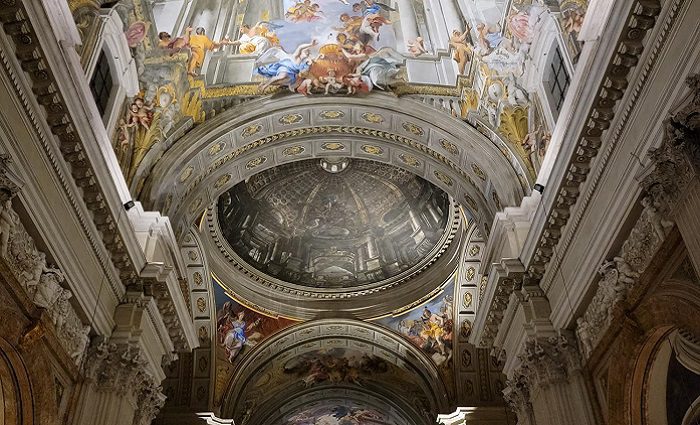
Free | Optical Illusion | Stunning
When you have some extra time in Rome, I highly recommend going inside any church you walk by. There are plenty of opportunities: Rome has over 900 churches! Many of them look utterly non-descript from the outside, but when you step inside, prepare to be wowed.
My personal favorite became the 17th-century church Chiesa di Sant’Ignazio di Loyola for a couple reasons. First, there is an optical illusion using fabric to create the appearance of a dome. Quite entertaining. But second, if you come here when it’s almost dark outside, you’ll notice there are few lights on and you can’t see the ceiling well.
Electricity is expensive, so look for the box next to the viewing mirror in the middle of the room and put in a euro or two. Then watch the magic happen when the lights turn on. The “oohs” and “ahhs” from fellow visitors will warm your heart almost as much as the sudden vision of the masterpiece ceiling above you.
Address: Via del Caravita, 8a
14. Eat One of Rome’s Most Authentic Dishes: L’Amatriciana
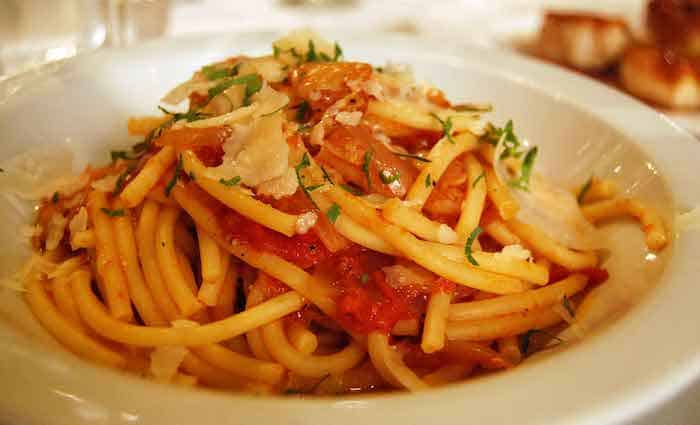
Pasta | Pork Based | Slightly Spicy | Primo
Rome is split between l’amatriciana and la carbonara. Both dishes are delicious, and it would be impossible to decide which one is better. I can’t take sides but I do tend to make l’amatriciana more often, so it’s my number one dish to order in Rome.
Like many of the best Italian dishes, this Roman favorite is made with simple ingredients. It’s often made at home with la passata, which is a quick tomato sauce base—but you couldn’t do that in a restaurant without Italians noticing. Ideally, you should use cherry tomatoes (pomodori ciliegini), fresh chili peppers (peperoncino), pork cheek (gaunciale), and most importantly pecorino cheese (pecorino romano).
For the pasta, you should use spaghetti or bucatini (spaghetti in the form of a straw). This is yet another cause for rivalry between the amatriciana purists—spaghetti or bucatini? Bucatini is arguably the original recipe, which I prefer as well.
In Rome, this dish could be served with spaghetti or even maniche corte, which are about half as long as rigatoni and used more commonly in Rome. You must try this dish. For more, check out some other top foods to try in Rome.
Where to get the best Amatriciana in Rome:
- Trecca – Cucina di Mercato — Ostiense, super Roman.
- Trattoria Vecchia Roma — Near Termini.
Not ready to book a tour? Find out if a Rome food tour is worth it.
15. Visit the Orange Groves and the Keyhole
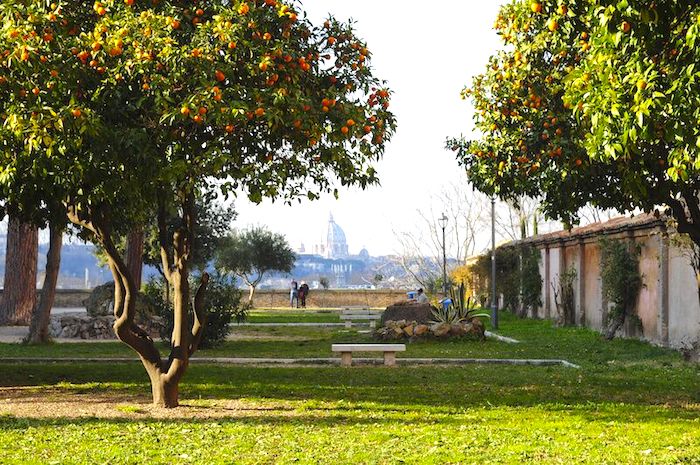
Free | Aventine Hill | Stop By Attraction
This is one of those magical little places in Rome and a total treat! It’s one of the great free things to do in Rome as it’s less a full park and more of a viewpoint.
The park, which is pretty small at 24,000 square feet (7,800 meters), sits on top of Rome’s famed Aventine Hill and is just a few steps from the keyhole. It was designed in 1932 and is attached to the Basilica of Santa Sabina.
A very peaceful viewpoint, you won’t find many visitors. You’ll have to rent a bike or take a taxi to get here as it sits high atop Aventine hill, which puts some strain on your legs. Don’t forget to walk over to the keyhole for that Insta-worthy view!
Address: Piazza Pietro D’Illiria
16. Walk Across Tiber Island
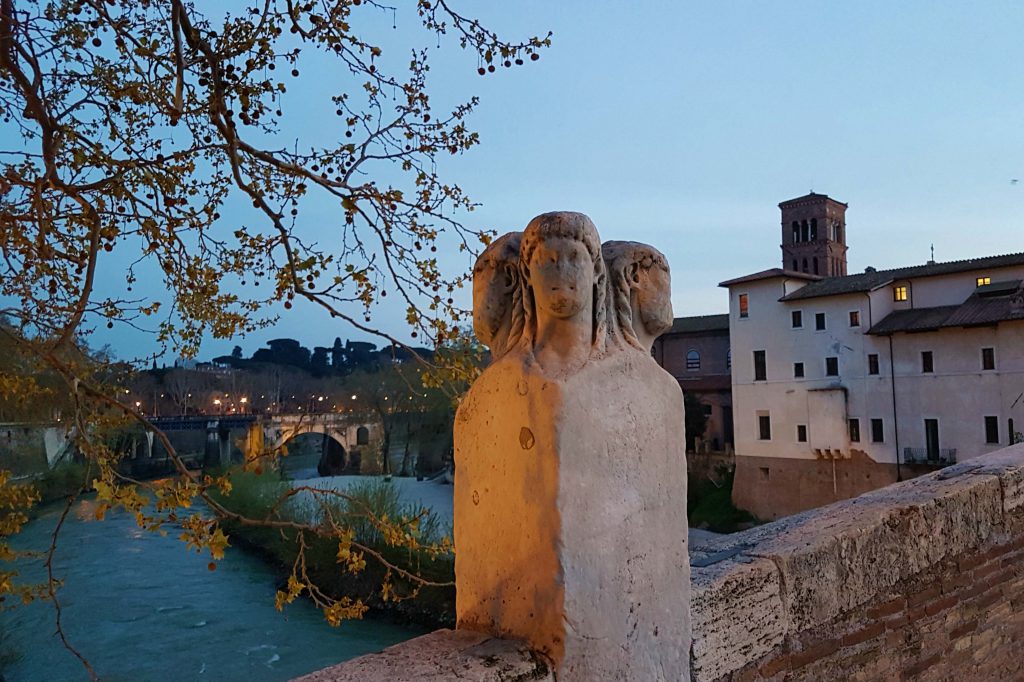
Free | Stop-By Attraction | Jewish Ghetto/Trastevere
Tiber Island is an amazing modern-day site. Two bridges connect the banks of Rome to this small island, which is home to one of the city’s main hospitals. Locals say that if you weren’t born on Tiber Island, you’re not truly Roman.
It’s common to hear locals use being born on this island to add credibility to an argument. Two Romans could be debating a historical fact or traditional cuisine and if one says, “Listen, I was born on Tiber Island,” that can often be enough to end the argument.
Legend has it that the body of Rome’s last king prior to the republic, Tarquinius Superbus, was thrown into the Tiber river in 510 B.C. and that eventually, sediment built up around him to form the island. This is almost definitely not true, but I love a good legend.
Also, you’ll see bars open on Tiber Island and even a mini-movie theatre in the summer. It’s one of my favorite places to sit down and have a drink with friends and loved ones in the heat of summer. Often, the cool water flowing around the island can drop the temperature a degree or two.
Address: Tiber Island
Not ready to book a tour? Check out our best Rome tours to take and why.
17. Test the Mouth of Truth
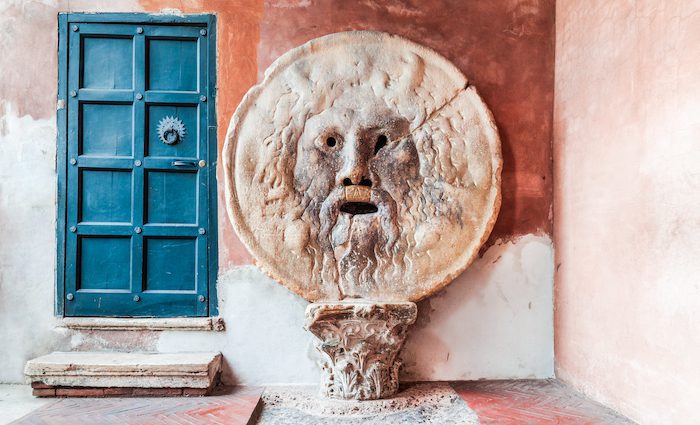
Small Donation | Stop By Attraction | Santa Maria in Comedian Church
In Italian, the Mouth of Truth is known as la Bocca della Verità and the translation is quite literal. The disc is well over 2,000 years old. Its first home was most likely the Temple of Hercules where it may have served as a drain cover for runoff water.
Now, it exists in the Santa Maria Cosmedian Church, which is across the street from the Temple of Hercules. The figure of Oceanus is on the front of this 3,000-pound (1,300-kilogram) disc. Oceanus is a sea titan god, and you can also find him as the centerpiece of the Trevi Fountain.
Today, visitors pay €2 to put their hand in the mouth of truth and take a picture. Normally, there’s a bit of a queue but it moves quickly. The legend has it that if you put your hand in the mouth and tell a lie, it will bite your hand off. The legend was immortalized in the film “Roman Holiday” in 1953 when Gregory Peck and Audrey Hepburn’s characters visited this monument.
While there, make sure you step into the Church of Santa Maria Comedian. The word “comedian” derives from a Greek word for pure. Inside the church, you’ll find an important Christian relic, the skull of St. Valentine.
Address: Piazza della Bocca della Verità, 18
18. Read the Story on Trajan’s Column
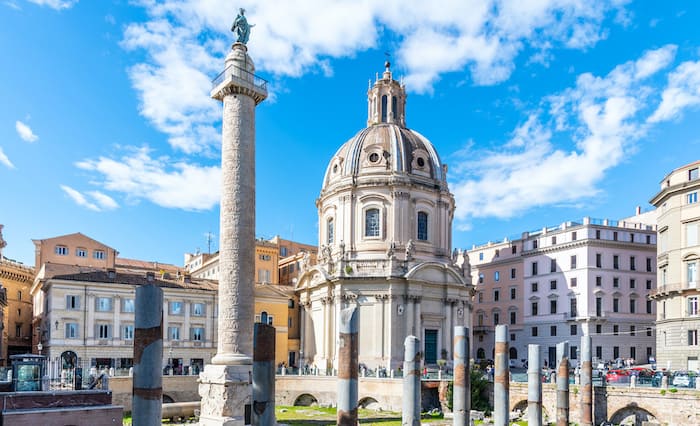
Free | Quick Stop Attraction | Piazza Venezia or Colosseum
Trajan’s column is an incredible monument and surviving piece of propaganda from the second century A.D. The column has an incredible history and plays a very important role in our ability to put together ancient timelines.
Standing 114 feet tall (35 meters) and constructed approximately in A.D. 113, the column honors Emperor Trajan for his conquests in Dacia, modern-day Romania. It’s located in Trajan’s Forum, which is also dedicated to the late emperor.
It’s an incredible feat of engineering by none other than Apollodorus of Damascus, one of the most influential architects of all time. He can take credit for two of the best-preserved buildings in Rome. The structure was constructed with 20 massive Carrara marble cylinders stacked on top of a base. The column is wrapped with a helical frieze that winds 23 times around the column and features 2,662 figures telling 155 stories or scenes.
Ok, so a massive column survived this long with some stories on it. What’s the big deal? The column is hollowed out in the center and there’s a staircase winding all the way to the top. At the top, you’ll find a statue of St. Peter. Originally, the figure of Trajan occupied this prime spot until it was removed by the church and replaced with St. Peter.
The symbolism goes further. Trajan’s Forum is home to Trajan’s Market, which was a multi-level market that even featured luxury apartments at the center. Yep, Romans had the same material aspirations we do. Prior to the market’s construction, there was a massive 114-foot hill here. Trajan built the column, a massive phallic symbol, the same size as the hill it replaced and topped it with a statue of himself—amazing.
Address: Via dei Fori Imperiali
19. Look Down on the Colosseum and Roman Forum
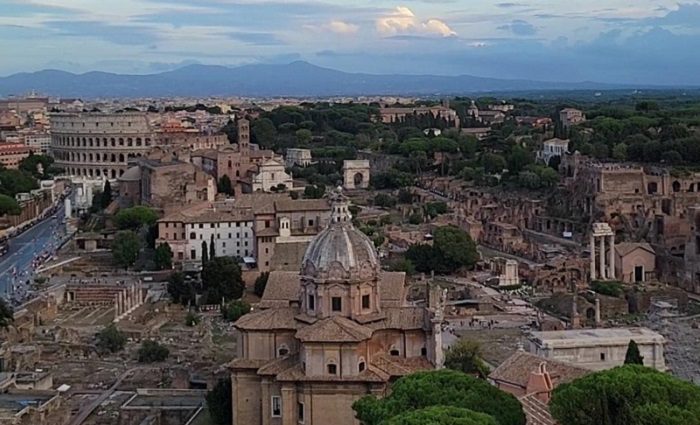
€ | Terrace Views | Piazza Venezia
Want another incredible view of Rome, particularly the Colosseum and Roman Forum? Then head to the massive structure that Romans have unaffectionately dubbed “the Wedding Cake” since it’s a monstrous white building on Via del Corso. It’s also known as the Victor Emmanuel II National Monument and the Altar of the Fatherland.
While Italians might not love it, I happened to find it utterly fascinating and fun to explore at different times of the day, night , and even during a storm! But I digress. The cool thing to do here besides exploring the museum is to head to the back side of the building and purchase a ticket to go up the glass elevator to the upper terrace. The views of Rome are unlike any other view here!
Look down on the Roman Forum and the Colosseum to see it in an entirely new way. The terrace closes at 7 pm, but if you’re here off-season, that means you could go up at sunset, which is my recommended time to visit. The cost of the ticket is worth it and cheaper than many viewpoint tickets in the states.
Pro tip: I recommend going early and standing in the fast-moving line to buy your ticket as the online system isn’t reliable.
Address: Piazza Venezia (cost starts at €12, free for disabled and under 18)
20. Throw Some Coins in the Trevi Fountain
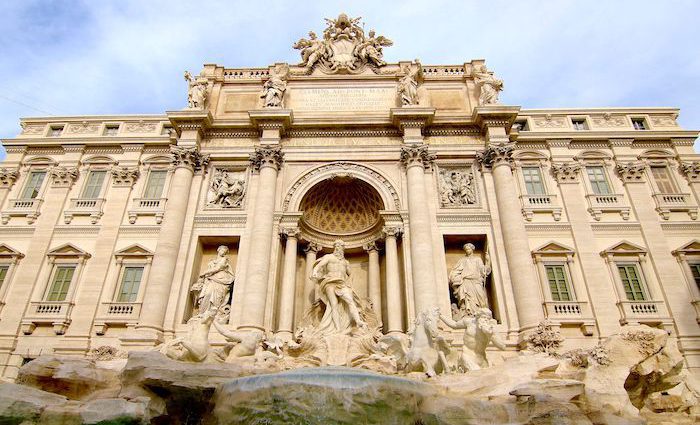
Free (plus the coins) | Baroque Fountain | Quick Stop Attraction | Open 24/7
Trevi Fountain is among the world’s most magnificent fountains. This enormous masterpiece is situated at the back of Palazzo Polli right in the center of Rome and is completely free to visit.
Gian Lorenzo Bernini was originally going to design the fountain in the 17th century, but nothing ever came of it. A hundred years later, Nicola Salvi got the job by losing a competition for the best drawing. Salvi lost to a Florentine named Alessandro Galli. But the Romans were unhappy about a Florentine getting the commission. So, eventually, Salvi “won” the job out of fear of the mob.
Construction began in 1732 and was completed in 1762, eleven years after Salvi’s death. The job was handed to architect Giuseppe Pannini, who worked with multiple sculptors to finish the project. The fountain’s facade tells a gripping story of its history. Discover the history of Trevi Fountain and why it is so famous ahead of your visit. Also, there are a few great restaurants nearby the fountain where you can stop for a bite to eat.
Address: Piazza di Trevi
21. Shop Near the Spanish Steps
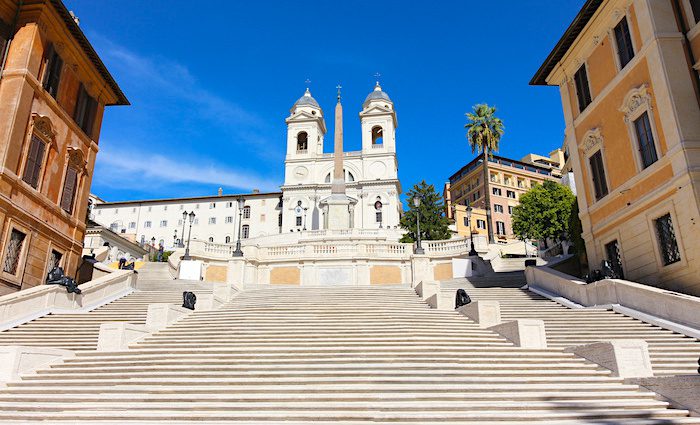
Free | Local | Stop By Attraction | Near Posh Shopping | Open 24/7
The Spanish Steps and Piazza di Spagna are synonymous with high-end shopping due to the concentration of luxury stores nearby. Italy’s most famous shopping street, via Condotti, is directly opposite the Spanish Steps in Piazza di Spagna.
The Italian name for these steps is La Scalanita di Trinita di Monti, which means the Steps of Three Tiers—a very straightforward name that describes their architectural form. Simple yet beautiful: three tiers of steps.
So, why do we call them the Spanish Steps? The Spanish Embassy is located about a hundred meters south of the steps in Piazza di Spagna or the Square of Spain. There are a lot of great things to do and see in this area.
Address: Piazza di Spagna
Not ready to book a tour? Find out if Rome tours are worth it.
23. Day Trip to Pompeii and Sorrento
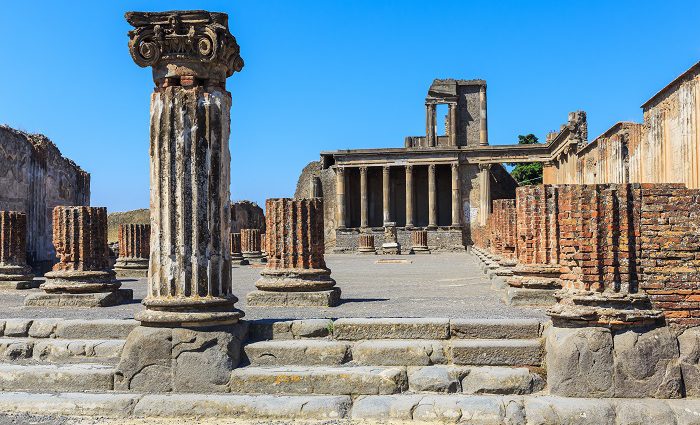
€€€ | Archeological Site | Roman City
Getting to Pompeii from Rome takes just over 2.5 hours by car and about 3.5 hours by train, which makes it a great and accessible day trip from Rome.
If you take the train, you’ll spend approximately €65 for a roundtrip on trains plus transportation to and from the stations. Also, there’s the admission ticket to enter Pompeii, which will cost about €18 for adults and €2 for EU citizens between 18-25 years old. So, it’ll set you back about €75 per person to visit Pompeii—a large archaeological site brimming with history—without a guide to help you navigate this ancient city.
Still not sure you want to try to get to Pompeii on your own from Rome? We’ve made it easy with our Pompeii from Rome day trip.You’ll get private transportation to and from Pompeii, a guided tour of Pompeii (2 hours), and a stop in Sorrento to experience the awesome Amalfi Coast vibe. All of this is done by coach, with a trip leader to keep you on track.
Not ready to book a tour? Find out if a Pompeii day trip from Rome is worth it.
24. Storm Hadrian’s Fortress at Castel Sant’Angelo
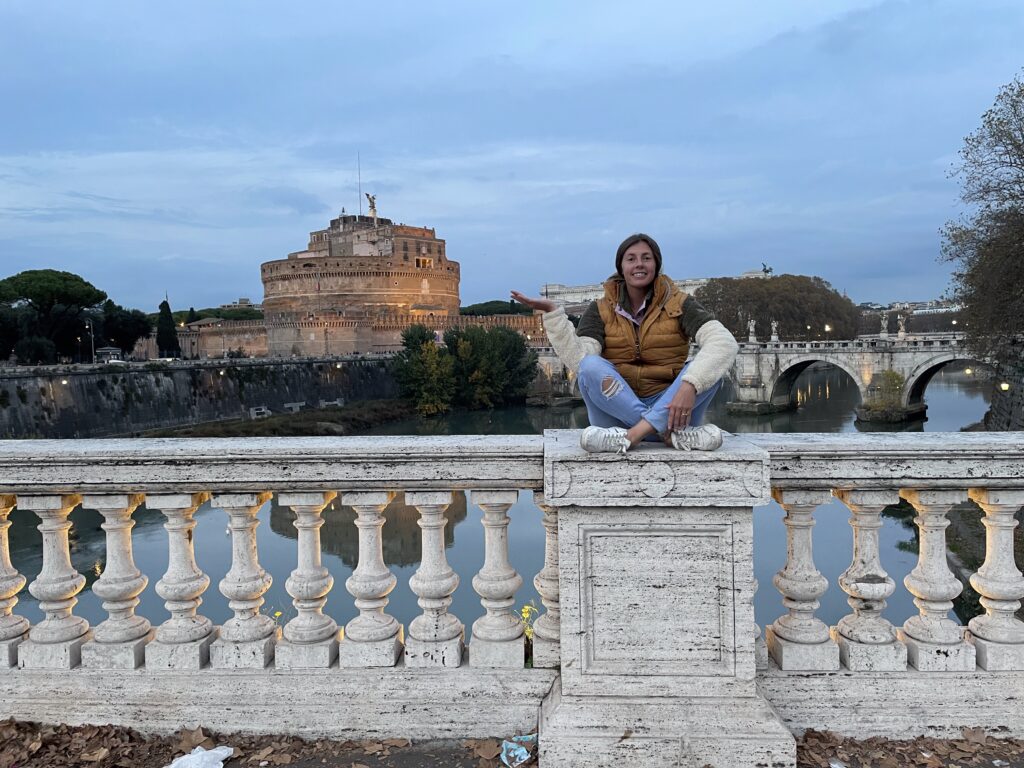
€€ | Castle & Museum | Papal Refuge
Castel Sant’Angelo started as the tomb of Emperor Hadrian, but its story didn’t end there. Over the centuries, it morphed into a fortress, a papal residence, a prison, and now a museum—with some seriously epic views. Inside, you’ll find everything from ancient frescoes to opulent papal apartments and angelic sculptures by artists like Bernini.
Don’t miss the legendary Passetto di Borgo, a secret tunnel connecting the castle to the Vatican, once used by Popes fleeing danger. Oh, and the name? That comes from the Archangel Michael, who supposedly appeared here in 590 AD to signal the end of the plague. Pretty impressive, right?
A great way to explore the history of Castel Sant’Angelo is to join our Castel Sant’ Angelo Skip the Line Small Group Tour.
25. Try a Jewish Artichoke in the Jewish Ghetto
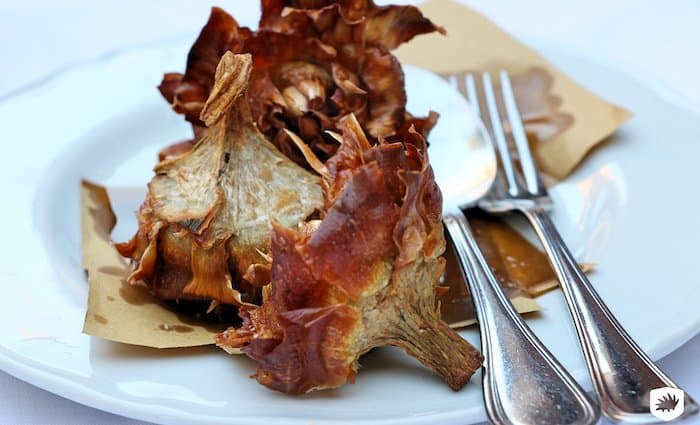
Artichoke | Antipasto | Vegetarian
Artichokes thrive in Rome’s climate, so they are very popular in the city. Two main recipes include them: Alla Giudia (Jewish-style above) and alla Romana (Roman-style). Don’t worry, you are allowed to prefer either without fear of reprisal, but the Jewish ones almost always come out the victor.
Carcioffi alla Giudia, Jewish-style artichokes, are seasoned with salt and pepper and then fried twice in olive oil. Twice-fried is how they get their super crispy texture. They’re also fried in olive oil because it’s a high-quality oil with the right boiling point. So, they really aren’t Jewish artichokes unless they are fried in olive oil twice.
Carciofi alla Romana, Roman-style artichokes, are a world apart. The preparation and cooking time is more intensive and the outcome is different. These artichokes are most often served cold but cooked for up to 30 minutes. They are seasoned with lemon, mint, garlic, olive oil, and black pepper.
This may sound a bit eccentric and possibly politically incorrect, but I would stick to religion on this one. If the restaurant is run by Catholics, I would order Roman-style artichokes. If it is Jewish-run, I would order the Jewish-style artichokes without question. How do you know who runs the restaurant without asking an awkward question? Well, the Jewish Ghetto is still occupied mostly by Jews.
Where to get the best Jewish Artichoke in Rome’s Jewish Ghetto:
- Piperno (Outdoor seating)
- Sora Margherita
- Al Pompiere
- Yotvata (kosher)
26. Visit the Exclusive Vatican Gardens
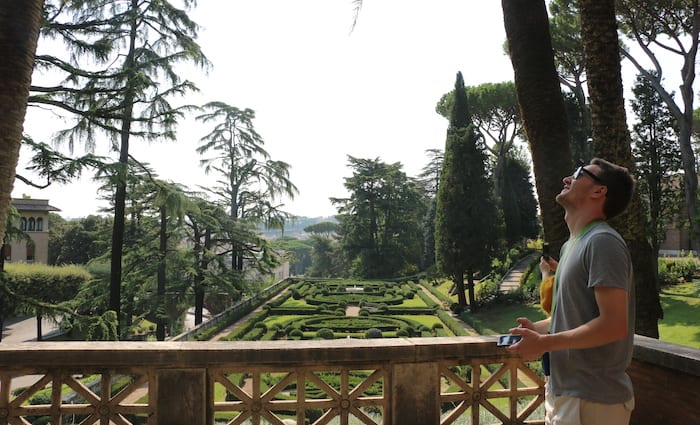
€ | Vatican and Sistine Chapel Tour | Vatican Gardens | Lunch Included | Castel Gandolfo
The Vatican Gardens are a beautiful and well-manicured outdoor space with fountains located within Vatican City. You’d never know you were in the bustling city of Rome!
Getting into these gardens is more difficult than you’d think. Luckily, we offer tours and other ways to visit them! It’s a 57-acre complex complete with its own train station. To enter, you should join our guided tour of Castel Gandolfo, which is a really cool, full-day experience.
Not religious? No worries, this day trip is not centered around religion. You can visit the Vatican, see the Gardens, and head to the Pope’s summer home for breathtaking views, food, and fun!
The best part is that the tour’s price is inexpensive, considering the access you get. This is because the Vatican is working directly with local tour operators like us to drive more attention to this amazing site.
Address: Vatican Gardens

Not ready to book a tour? Find out if a Vatican tour is worth it.
27. Step into the Unparalleled Pantheon

Free to Enter | Best Preserved Monument from Antiquity
Once one of Rome’s greatest structures, the Pantheon is the best-preserved structure from antiquity. The building survives today as a Catholic church, Santa Maria ad Martyres, but was originally a pagan temple.
The name may mean “Of All The Gods”, but there’s some speculation around that. Construction began at the beginning of the second century under the rule of Emperor Hadrian and it was inaugurated about ten years later.
Commissioned by Marcus Agrippa, the original structure burnt down twice due to its wood construction. Hadrian had the current structure made out of stone, which is why it has stood the test of time.
While it is unknown who the original architect was, it’s a common belief that the only architect talented enough to construct the interior dome would have been Apollodorus of Damascus.
A great way to explore the history of the Pantheon and other important sights is to join our Rome in a Day tour. Be sure to check out all the other top things to see and do around the Pantheon, plus the best places to eat nearby.
Address: Piazza della Rotonda
Not ready to book a tour? Check out our best Rome tours to take and why.
28. Take a Cooking Class
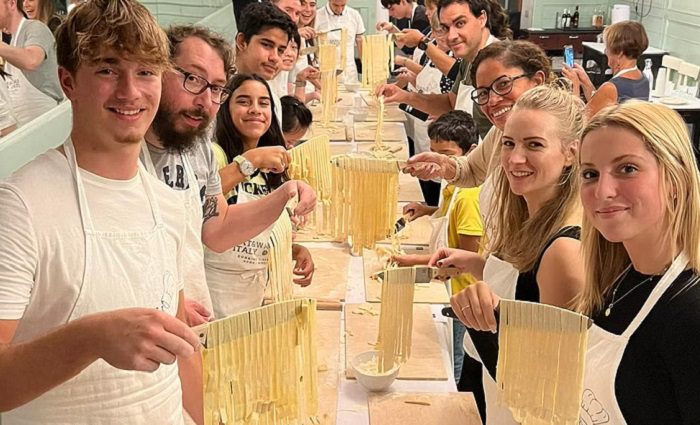
Cooking Class | Hands-On Skills | Led by Knowledgeable Chefs
Taking a cooking class in Rome offers a unique opportunity to immerse yourself in the city’s rich culinary heritage. You’ll learn to make classic dishes like pasta alla carbonara using fresh, high-quality ingredients from local markets.
Guided by experienced chefs, you’ll gain hands-on skills and insights into Italian cooking techniques. The experience fosters a sense of community as you share your creations with fellow participants.
Plus, you’ll take home not just recipes, but also the confidence to recreate authentic Roman flavors. Overall, it’s a delicious way to connect with the culture and make lasting memories.
Check out all of the best cooking classes in Rome.
29. Ditch the Day-Long Trek to Pompeii and Explore Ancient Rome’s Lifeline Instead
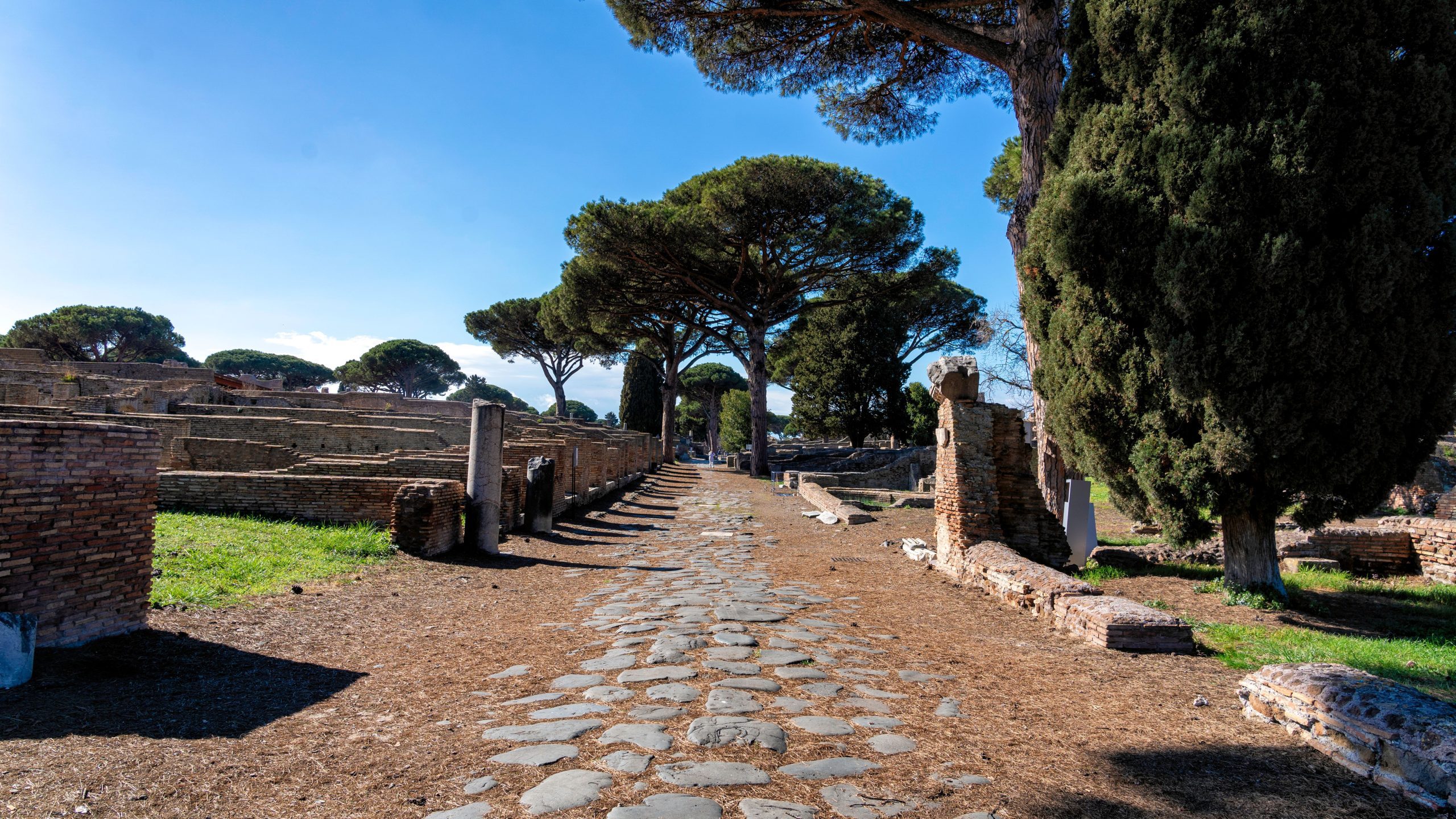
€€ | Archaeological Site | Hidden Gem | Easy Day Trip
If ruins could talk, Ostia Antica would have a lot more to say than Pompeii. Why? Because unlike Pompeii, which was frozen in time in one catastrophic moment, Ostia faded slowly, leaving behind a Roman city that feels eerily alive. Still today you’ll find shops with counters, mosaicked bathhouses, a 4,000-seat theater, and even an ancient tavern where sailors probably drank too much. It’s less touristy, better preserved, and only a 30-minute train ride away, making it one of the most underrated day trips from Rome. Want to hear its stories instead of just wandering? Join our small-group tour for the full experience.
30. Get Tricked by a Baroque Illusion
€ | Renaissance & Baroque Art | Architectural Wonder | Campo de’ Fiori Area
Palazzo Spada is the kind of place that rewards those who stray from the usual tourist trail. The gallery holds an impressive collection of 16th- and 17th-century paintings, but the real reason to visit is Borromini’s forced perspective corridor. What looks like a grand hallway stretching 40 meters is actually a cleverly crafted illusion spanning just 9 meters—one of the best visual tricks of the Baroque period. If you’re the kind of traveler who likes to find the spots nobody else is talking about, this is the one for you.
Here’s Where To Stay in Italy’s Most Popular Destinations
Rome, Florence, Venice, Amalfi Coast, and Capri

